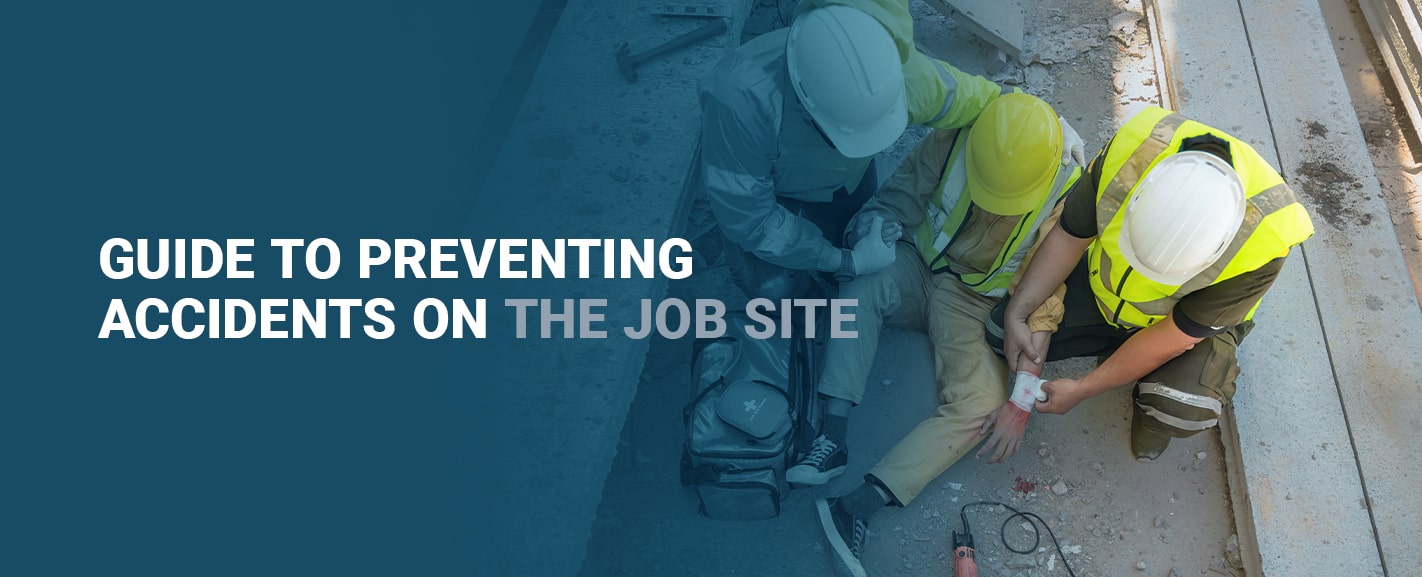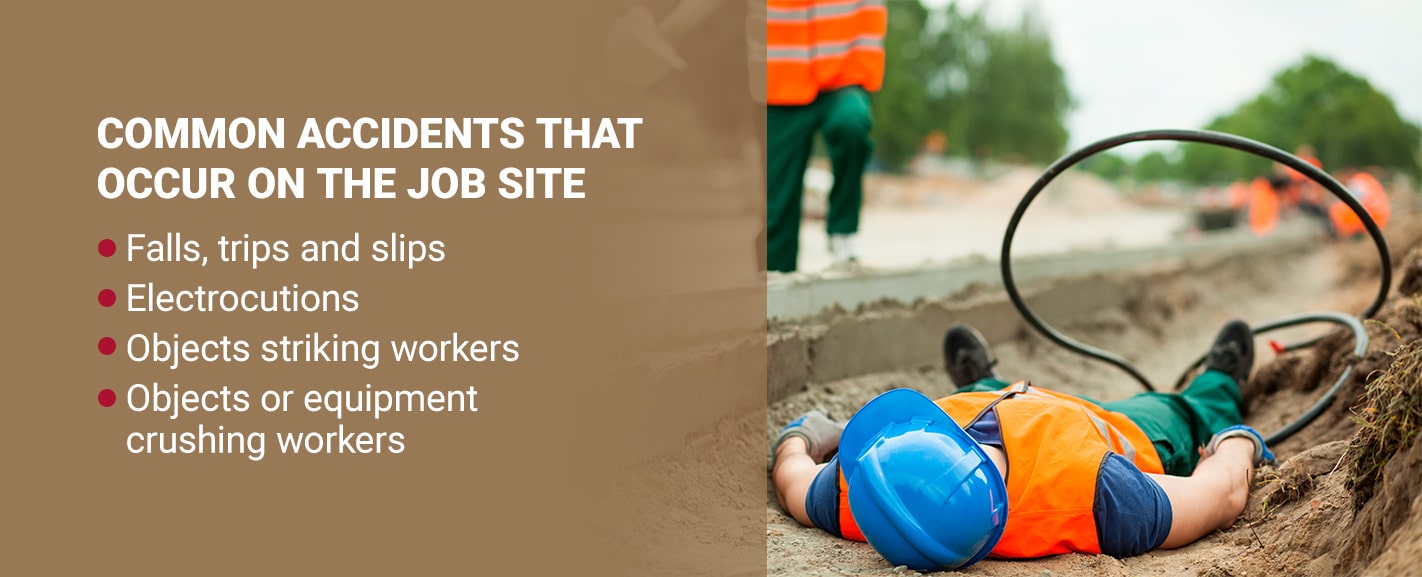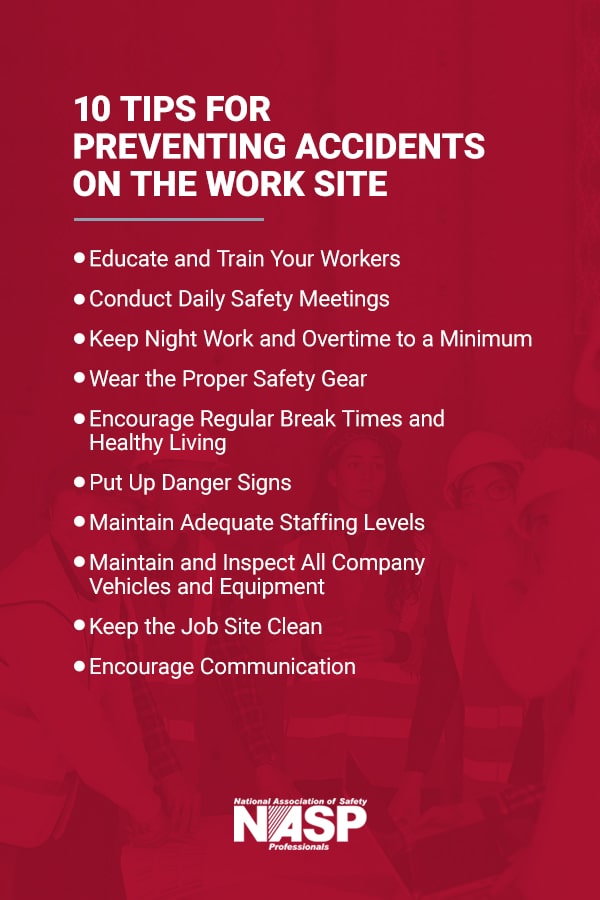
There’s a lot of action happening on a job site. Construction workers perform their tasks; machines move around the site, and trucks arrive to drop off deliveries. When everything’s going smoothly, a job site can feel like clockwork — but without warning, an accident can happen that changes everything.
While accidents are impossible to avoid completely, you can take measures to reduce their chances of happening and stop them from occurring in the first place. Job site accident prevention is essential to everyone’s safety. In this guide to preventing accidents on the job site, you’ll learn some practical ways to keep your workers safer every day they show up to work.

Common Accidents That Occur on the Job Site
Construction job site injuries are among the most common types of workplace injuries across industries. According to OSHA, 20% of workplace fatalities in 2019 resulted from construction site accidents. There were 1,061 construction site deaths in 2019 alone.
Preventing accidents on the job site starts with knowing the reasons for these incidents. Here are the four most common contributing factors for job site injuries, known around the industry as the “fatal four”:
- Falls, trips, and slips: The Centers for Disease Control and Prevention (CDC) reports that falls account for more than one in three fatal injuries in construction. Therefore, falls, slips, and trips are the most common cause of job site-related injuries and deaths. As a result, it’s your responsibility to reduce the chance of situations occurring where someone could fall and sustain an injury.
- Electrocutions: A worker can experience electrocution in several scenarios. These situations include making contact with power lines, exposed wires, or faulty equipment. A worker can even be electrocuted when mishandling extension cords or handling damaged extension cords. It’s also important to note that electrocution may occur when digging underground and striking live power lines beneath Earth’s surface.
- Objects striking workers: The hectic nature of a job site raises the chances of workers suffering injuries from making contact with objects, including the moving arms of machinery, vehicles, and even materials that other workers are moving. Some of the most common reasons for object-related injuries happen when objects slip, fly, move or fall near workers. Falling objects are especially prevalent on vertical job sites when workers could be completing tasks below each other.
- Objects or equipment crushing workers: Like objects striking workers, objects and equipment can crush workers on the job site. This scenario happens when a worker is compressed or caught by objects or equipment. It may also occur from collapsing structures, materials, or equipment. Though other types of workplace injuries are more common, injuries from being crushed by objects or equipment are the most fatal type of injury in construction.
Purchase Our Certified Safety Manager: Construction (CSMC) Course

10 Tips for Preventing Accidents on the Work Site
The injuries listed above can happen at any time. Fortunately, with the right tips on worksite accident prevention, you can do your part to keep your workers safer every day.
Here are ten helpful tips you can use to start implementing safer practices on the job:
1. Educate and Train Your Workers
Proper workplace safety must start with a solid education. Your workers need to know about safe practices if they’re ever going to have a chance to implement them in a real-world situation. Proper workplace safety is especially important considering all of the variables associated with working on a construction site.
Teach your workers what it means to stay safe on the job site in a variety of circumstances. Every job site is different, and work can rapidly change from one day to the next depending on where your team is at on their job timeline. Then, train your workers on the job so they can do their tasks safely and with confidence moving forward.
2. Conduct Daily Safety Meetings
Learning and remembering proper safety protocol must continue even after educating and training your workers. Consider hosting daily safety meetings at the start of every workday. This approach will keep proper safety practices at the forefront of everyone’s mind as they go forth to take on the day’s tasks.
Though daily safety meetings may seem like a big responsibility, the results will be worth it. Cultivating a work environment of safety is worth the few minutes spent at the start of the day. These meetings are especially important when working on job sites with more dangerous risk factors.
3. Keep Night Work and Overtime to a Minimum
You may be able to reduce and avoid accidents by sticking to a regular workweek. Of course, the time may come when your crew may need to work a longer day to finish a time-sensitive task. But consistently working long days or working deep into the night can take its toll on your workers’ energy levels, increasing accident risks.
More mistakes can happen as your crew grows tired. Plus, even with job site lighting, people’s visibility could decline as the sun goes down. Keep night work and overtime to a minimum so your workers can be as sharp as possible when they’re on the clock.
4. Wear the Proper Safety Gear
Due to the unpredictable nature of construction sites, your workers should wear the proper protective gear to stay safe. Job site protective gear includes items like the following:
- Hardhats
- Eyewear
- Gloves
- Earplugs
- Steel-toe boots
- Harnesses
- Visors
- Reflective or high-visibility clothing
Some of the above gear may feel like a hindrance in certain scenarios. Your workers may even want to skip wearing the gear to save time and feel more comfortable. But remember, it’s better to need the gear and have it than to face a dangerous situation and lack the proper protective gear.
5. Encourage Regular Break Times and Healthy Living
Safe work practices can extend into how your workers spend their time when they’re not working, too. Break times are crucial to keeping your workers rested and ready for action. Encourage your crew to take breaks and lunches at appropriate times so they can rehydrate, eat some food and return to work re-energized.
Besides taking breaks, you should inspire your workers to lead healthier lifestyles to help them perform their best on the job. Eating healthier foods that are low in fat may help people feel clearer and more energized. Workers should also stay hydrated by drinking water and electrolyte-filled beverages. Staying hydrated will help workers stay safer, especially on hot days when they could be at a higher risk of dehydration.
6. Put Up Danger Signs
Some areas of the job site may be more dangerous than others. It may be hard to tell that these areas pose threats simply by looking at them. In these instances, you need to put up signs to let workers know about the potential risks of entering certain spaces.
For example, you can put up signs letting workers know that an area has live electrical wires. Include signs saying electricity must be deactivated before working in that area. Section the area with ropes and pylons to make it difficult for a worker to enter a dangerous area accidentally.
Even a simple sign with the word “danger” can be enough to reduce accidents.
7. Maintain Adequate Staffing Levels
You must make sure your crew size corresponds with the task at hand. If you’re doing a minimal repair, then a small crew will do. But for larger projects, you may need a crew of dozens of people to get the job done. The last thing you want to do is have a small crew for a large project and expect them to accomplish the same amount of work in a short amount of time.
When your workers get tired, the chances of making a mistake increase. Always make sure you have enough workers for the day’s tasks. Evenly distribute the workload to ensure your workers have enough energy to carry them through the day.
8. Maintain and Inspect All Company Vehicles and Equipment
Many job site accidents occur in company vehicles and equipment. While these accidents may result from operator error, they could also stem from improper maintenance and inspection practices. These are some of the easiest accidents to avoid by simply keeping your company’s vehicles and equipment in good working condition.
Prevent accidents related to malfunctions by staying on top of inspections. Preventative maintenance will catch any issues before they become serious problems, saving you money and time. Your workers should only go behind the vehicles’ controls if records prove they’re in safe operating condition. Further, only workers with the proper training should operate equipment on the job site.
9. Keep the Job Site Clean
A clean job site is a safe job site. Workers should always clean up after themselves at every step of the job process. Clean-ups can take many forms, including taking discarded materials to the dumpster, putting away tools after using them, or neatening up areas for easy navigation.
Items scattered across the ground can be a tripping hazard. Plus, some objects can obstruct signage, reducing your workers’ abilities to gain essential information about dangerous areas. If an evacuation ever needs to occur, having a clean job site will make the whole process easier.
Encourage your workers to keep a clean job site to reduce the risk of accidents.
10. Encourage Communication
Your job site should be an area of healthy communication. In fact, it’s better to over-communicate than under-communicate. If one person notices a hazard, they should let a supervisor know immediately so they can take proper action to fix it. If one team needs to turn on the power in a certain area, they should let all other teams know that the electricity is going live.
Simple communication can go a long way toward reducing accidents. Instruct your workers on how to communicate properly, and your job site will be safer for it.
Purchase Our Certified Safety Manager: Construction Course Online
What to Do When an Accident Has Occurred
Even when you prepare and follow the above tips, accidents can still happen. It would help if you prepared for accidents like they’re inevitable because the day will come when one occurs on your job site. In this event, you should be prepared.
Here are three tips on what you should do when an accident occurs:
- Report the accident immediately: You must report the accident to the proper channels as soon as possible after it occurs. Even if zero injuries occurred, reporting the accident right away keeps everyone in the loop to avoid further accidents.
- Address the hazard: If a specific hazard on the job site contributed to the accident, you must address this hazard as soon as possible. It’s bad practice to leave hazards intact on the job site once you know about them. Address the hazard to stop it from causing further accidents, injuries, or roadblocks to productivity.
- Follow legal protocols: Legal protocols exist to protect your company and any injured parties. Depending on your state, injured workers may only have a limited window of opportunity for them to receive workers’ compensation. Ensure injured workers get the help they need and follow all protocols to protect your company’s legal well-being.

Safety Training From National Association of Safety Professionals (NASP) to Avoid Accidents on the Job Site
One of the best things you can do for your workers and your construction site is receive job site safety training. As a safety supervisor, it’s your job to ensure the workplace is as safe as possible. For this, you need knowledge of best practices. You can get this valuable knowledge from NASP.
NASP provides high-quality certificate courses to help you keep the job site safe while advancing your career as a safety professional. NASP’s full list of online courses helps you hone in on the areas of study that pertain to you. With these safety certificates, you can display your extensive knowledge of workplace safety. Plus, you can take these courses at a pace that works for you, giving you control over your progression.

Contact NASP for Job Site Safety Training
Education and training are two crucial components for avoiding future accidents on the job. If you’re ready to take the next step toward better job site safety, contact NASP online today. Our helpful team is ready to provide answers to any questions you may have.
For more safety information, check out our blog. At NASP, we care about worker safety and provide the certificate course needed to foster a safer job site. We look forward to helping you further your goals of achieving a safer job site for your workers.





